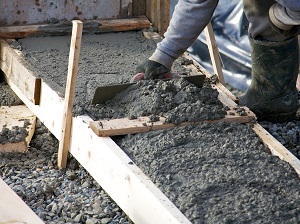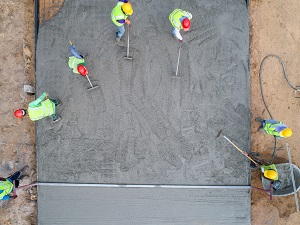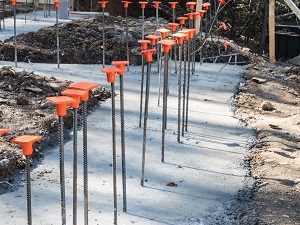Concrete is one of the most widely used construction materials in the world and safety hazards exist in all phases of concrete production and construction work with concrete, including:
- skin, eye and respiratory irritation due to cement dust exposure
- inadequate equipment guarding or lockout/tagout systems on machinery
- overexertion and back injuries
- slips, trips and falls
- chemical burns from wet concrete

Hazardous materials in concrete include:
- alkaline compounds such as lime (calcium oxide) that are corrosive to human tissue
- crystalline silica which is abrasive to the skin and can damage lungs
- trace amounts of hexavalent chromium that can cause skin and respiratory allergies
OSHA 1926 Subpart Q provides the specific standards for concrete including requirements for equipment and tools, cast-in-place concrete, formwork, precast concrete, lift-slab operations and masonry construction.
Anyone who works with concrete, or products that contain cement, is at risk of developing mild to severe skin problems, eye irritation and symptoms of respiratory distress.
Cement can damage the skin because it is caustic, abrasive, and absorbs moisture. It may also contain trace amounts of hexavalent chromium, a toxin that can cause allergic skin reactions and occupational asthma.

Wearing proper PPE, including gloves, boots and eye protection, is critical when working with materials that contain cement, like wet concrete. Butyl or nitrile gloves (rather than cotton or leather gloves) are frequently recommended for caustic materials such as cement. Gloves should be alkali-resistant. Wear sturdy, waterproof boots that are high enough to prevent wet cement from getting inside. When mixing, pouring, or during other concrete work activities that may endanger the eyes, suitable eye protection must be worn. When kneeling on fresh concrete, use a dry board or waterproof kneepads to protect knees from the wetness that can soak through fabric.
OSHA Standard 1926.701(f) No employee shall be permitted to apply a cement, sand, and water mixture through a pneumatic hose unless the employee is wearing protective head and face equipment.
Wash areas of the skin that come in contact with concrete in clean, cool water as soon as possible.

Visible airborne dust at concrete project sites can be hazardous to construction workers. Cement dust can irritate the eyes, nose, throat and respiratory system. Silica dust can lead to lung injuries like silicosis and lung cancer. Wear appropriate PPE, which may include eye protection like goggles, alkali-resistant gloves, and respiratory protection like a P-, N-, or R-95 respirator.
Cotton or leather gloves are not enough when working with concrete. Eat and drink only in dust-free areas. Use HEPA vacuums to clean up dust instead of dry sweeping. Reduce silica exposure by using wet methods and local exhaust ventilation during chipping, drilling, and sawing of concrete materials. Use soap and water to wash dust off the skin to avoid skin damage.
Because concrete work is labor intensive, it’s important that workers practice good lifting, carrying and working practices throughout the day to prevent back injuries, sprains and strains. Avoid working in awkward postures. Use hand trucks or forklifts for materials handling when possible. Use proper lifting techniques. Ask for help if a load is too heavy. Practice good housekeeping on site to minimize slip and trip hazards.

Because heavy equipment like concrete trucks, cranes and forklifts are often used on construction sites where concrete work is being completed, all workers must be aware of struck-by, caught-in and crushed-by hazards.
Ensure all vehicles and equipment are maintained in good working order and are inspected regularly. Only trained and authorized workers should be allowed to operate heavy equipment. Avoid overloading hoists, cranes and forklifts. All back-up alarms on heavy equipment must be functioning properly. Use care with the load out chute on concrete mixers to avoid injuries to hands and fingers.
Never ride on the concrete buckets. Do not walk or work under overhead loads, including concrete buckets while they are being elevated or lowered into position.
OSHA Standard 1926.701(e)(2) To the extent practical, elevated concrete buckets shall be routed so that no employee, or the fewest number of employees, are exposed to the hazards associated with falling concrete buckets.
Identify and fix slip, trip and fall hazards throughout the concrete construction project including slippery surfaces, damaged ladders and walkways, and loose hand-holds on heavy equipment.
OSHA Standard 1926.701(b) All protruding reinforcing steel, onto and into which employees could fall, shall be guarded to eliminate the hazard of impalement.
For impalement protection, protruding rebar must be capped or guarded.

.jpg)

.jpeg)